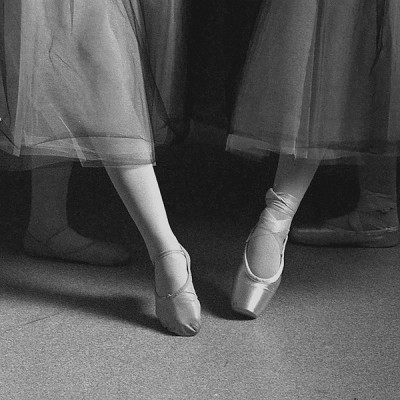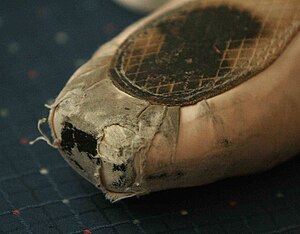Every ballet dancer wants to dance en pointe. But not every ballet dancer should.

There is something about these pink satin slippers that entices all ballet dancers young (and older).
Pointe shoes have a certain mystique and there is a well-earned sense of accomplishment that goes along with getting that first pair. It’s a symbol for the student that she has graduated into something “bigger and better.”
Young dancers don’t usually care that pointe work is sometimes painful and frustrating with slow and hard-won rewards. The pull of pointe shoes is a powerful one.
How will your teacher decide if you are ready for pointe work?
Why might she decide you are not ready to dance en pointe?
And what can you expect when you get your first pair of pointe shoes?
What Determines Pointe Readiness?
As a teacher, it is not easy to tell an eager student that she is not yet ready for pointe shoes. There are many factors involved when considering each individual’s preparedness.
Number one, is safety.
Is the student ready to safely work at this level?
“The bones of the foot are not fully developed, strengthened and hardened until sometime in the teenage years. Naturally there is a great deal of individual variation. If a young dancer attempts pointe work without proper strength and technique, there is a chance that she will permanently damage those not fully developed bones. Body weight times momentum creates a great deal of force.” — When To Start Pointework? via Gaynor Minden FAQ
“Students attempting pointe work before being ready risk, at the very least, building bad habits which may take years to correct. More serious is the potential for injury or permanent damage to the bone or muscle structure of the foot, which far outweighs the risk of disappointment.” — To The Pointe by Janet Parke
General Requirements:

Though teachers may have their own set of criteria, these requirements are widely accepted within the dance community:
- At least 11 years of age.
- At least 2 years of ballet training.
- Taking at least 3 full hours of ballet per week.
- Responsible enough to bring all ballet equipment needed.
- Dresses appropriately for class.
- Attentive in class and applies corrections well.
Physical Criteria:
A general (not necessarily complete) list of what you need to be able to DO.
- Maintains turnout while dancing
- Demonstrates correct posture and alignment in positions and while moving
- Shows awareness of proper ankle and foot alignment, avoiding sickling or rolling-in
- Effectively uses plié while dancing
- Stretches or points the foot while dancing
- Can piqué passé with a straight leg
- Can perform repeated relevé in the center without tiring & while maintaining alignment
- Can balance on one foot with the body correctly positioned over the supporting leg
- Coordinates movement well, particularly in regard to varying approach to relevé (from plié, from straight leg, stepping or springing into, etc.)
Attitude and work ethic play a large role in dancing at an advanced level. Students must display dedication during class and a strong commitment to the art form at all times.
What a Beginning Pointe Student Can Expect

Most teachers will take time from class to show students how to properly break-in and care for their shoes.
Some preparatory work involving the increased articulation (mobility) and strength of the feet is often added to the end of a full ballet class. If students wear pointe shoes at all during this time, it is usually under 10 to 15 minutes.
Pointe work begins at a slow, steady pace with exercises performed only with the aid of a barre.
Even standing in the pointe shoes requires ankle strength and can take some getting used to because of the uneven feel of the sole.
Eventually dancers will exhibit enough strength to complete some steps in the centre, however expect progress to be gradual.
What Pointe Is… And Is Not
Advancing to pointe work is a serious step and should be treated as such by students, teachers, and parents.
I have worked for studios in which the requirement for pointe work is much less than 3 hours per week and students were advanced simply because it was “their turn” to move up. The result of this method is always frustration for everyone involved.
At best, students end up “spinning their wheels” in regard to progressing and eventually leaving the barre for centre. At worst, they form bad habits and develop injuries.
Pointe work builds upon ballet technique and every struggle, problem, weakness, and deficiency is amplified with this new layer of difficulty. With this in mind, I must state the following:
- Pointe work is an evolution and extension of effective ballet training. It is NOT the end result of a particular number of years in ballet class, being a certain age, or even of an intense desire to dance en pointe.
- Pointe work is not a right.
- Pointe is not for everyone.
- Dancing en pointe is only a requirement for ballet dancers who are pre-professionals or professionals.
- Choosing not to dance en pointe (because you are not planning to be a professional ballet dancer) does not make you less of a dancer. It’s actually a very mature decision!
- Pointe work is a positive experience for those ready to devote themselves to quality ballet training.
Responding to a “No”
As a student, you should expect no less of a teacher than to instruct logically, carefully, and thoughtfully.
If your teacher’s criteria is unclear or if you have a question about what is required or how you might improve, arrange a meeting with your teacher to discuss this. However, make a commitment to respecting your instructor’s judgment and knowledge if she feels you are not yet ready for pointe work.
A teacher willing to say no to you has likely put a lot of thought behind the decision. A teacher who tells everyone yes is not someone I’d trust to train me.
What criteria do you or your teachers use to determine pointe readiness?
What else might a beginner expect?
Were you ready for pointe when you started?
Nichelle Suzanne is a writer specializing in dance and online content. She is also a dance instructor with over 20 years experience teaching in dance studios, community programs, and colleges. She began Dance Advantage in 2008, equipped with a passion for movement education and an intuitive sense that a blog could bring dancers together. As a Houston-based dance writer, Nichelle covers dance performance for Dance Source Houston, Arts+Culture Texas, and other publications. She is a leader in social media within the dance community and has presented on blogging for dance organizations, including Dance/USA. Nichelle provides web consulting and writing services for dancers, dance schools and studios, and those beyond the dance world. Read Nichelle’s posts.

